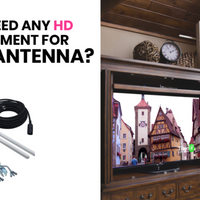Television antennas have long been an integral part of home entertainment setups, providing access to TV channels through free-to-air broadcasts. In recent years, the landscape of home entertainment has witnessed significant changes as antennas continue to reshape the way viewers interact with their TVs in 2023. This article delves into the impact and significance of TV antennas in the modern era of on-demand content and broadband access.
Understanding Different Types of TV Antennas
How do different types of TV antennas vary in their ability to access content?
TV antennas come in various types, such as indoor, outdoor, VHF, and UHF antennas, each designed to capture TV signals differently based on location and signal strength. Understanding the differences between these types allows viewers to choose the most suitable antenna for their needs. Indoor antennas are designed to be placed inside a home or building and typically have a smaller range than outdoor antennas. They are ideal for those who live in urban areas or near TV transmission towers, where the signal is strong. Indoor antennas are also smaller and easier to install, making them a convenient option for those who do not want to deal with the hassle of mounting an outdoor antenna.

Outdoor antennas, on the other hand, are designed to be mounted on the exterior of a home or building. They have a longer range than indoor antennas and are ideal for those who live in rural areas or far from TV transmission towers. Outdoor antennas can capture signals from further away and provide better reception in areas with weak signals.
VHF antennas are designed to capture Very High Frequency TV signals, while UHF antennas are designed to capture Ultra High Frequency TV signals. Many TV stations broadcast on both VHF and UHF frequencies, so having a combination VHF/UHF antenna can ensure that you receive all available channels. It is important to check which frequencies your local TV stations broadcast on before choosing an antenna.
What role do TV antennas play in redefining the media industry landscape?
TV antennas play a significant role in redefining the media industry landscape by offering an alternative to traditional cable and satellite TV services. They provide viewers with access to a wide range of TV channels, promoting diversity in content consumption. TV antennas are becoming more popular as viewers seek to reduce costs and have more control over their viewing options. With a TV antenna, viewers can access local channels for free, providing a wide range of programming including news, sports, and entertainment. This allows viewers to have access to a variety of content without the need for expensive cable or satellite subscriptions.
TV antennas also offer viewers the ability to access over-the-air channels in high-definition, providing crystal-clear picture quality without the need for a paid service. This can be especially appealing to viewers who are looking to cut costs and still enjoy a wide range of programming options.

In addition, TV antennas are a great option for viewers who live in areas with poor reception for traditional cable or satellite services. By using a TV antenna, viewers can still access a variety of channels without having to rely on a paid service that may not be able to provide a reliable signal.
TV antennas offer viewers a cost-effective and flexible way to access a wide range of TV channels. They promote diversity in content consumption and provide viewers with more options for their viewing needs. As the media industry continues to evolve, TV antennas will likely play a significant role in reshaping the way viewers consume content.
Exploring the advancements in TV antenna technology, including ATSC 3.0 integration.
Advancements in TV antenna technology, such as the integration of ATSC 3.0, have revolutionized the way TV signals are transmitted and received. This technology enhances the viewing experience by providing improved picture and sound quality while enabling seamless connectivity with smart TVs and streaming platforms. ATSC 3.0, also known as NextGen TV, is the latest standard for over-the-air television broadcasting. It offers many benefits over the previous ATSC 1.0 system, including higher resolution, better reception, and more efficient use of bandwidth. This means viewers can enjoy 4K Ultra HD picture quality, immersive sound, and interactive features on their TV sets.
Another major advancement in TV antenna technology is the use of multiple-input multiple-output (MIMO) technology, which allows antennas to receive and transmit multiple signals simultaneously. This improves signal reception and reduces interference, resulting in a more reliable and consistent viewing experience.
Furthermore, advancements in antenna design and materials have made it easier to install and position antennas for optimal reception. Many modern antennas are compact, lightweight, and have sleek designs that can blend in with any home decor.
These advancements in TV antenna technology have made it easier for viewers to access high-quality, free over-the-air television channels without the need for expensive cable or satellite subscriptions. With improved picture and sound quality, seamless connectivity, and easy installation, TV antennas have become an essential part of the modern home entertainment setup.
The Role of TV Antennas in Redefining Home Entertainment
How are TV antennas contributing to reshaping the way we interact with TVs in 2023?
TV antennas contribute to reshaping the way we interact with TVs in 2023 by offering a reliable and cost-effective means of accessing TV content. They cater to viewers seeking an alternative to traditional pay-TV services and provide access to a diverse range of TV channels. TV antennas allow viewers to access free over-the-air TV channels, which may not be available through their cable or satellite provider. This gives viewers the opportunity to watch local news, sports, and other programming without having to pay for a subscription.
Additionally, TV antennas provide HD quality content without the need for an internet connection, making it a convenient option for viewers in areas with poor internet connectivity or for those looking to reduce their reliance on streaming services.
TV antennas offer a one-time cost for the hardware, with no additional monthly fees, making it a more affordable option for consumers who are looking to save money on their TV services.
TV antennas are reshaping the way we interact with TVs by providing a reliable and cost-effective means of accessing TV content, offering viewers more choices and flexibility in how they watch television.
Why is there a resurgence of interest in TV antennas amid the rise of broadband access?
Despite the rise of broadband access and streaming services, there is a resurgence of interest in TV antennas due to their ability to provide access to live TV broadcasts and local channels not available through streaming platforms. This resurgence highlights the enduring appeal of TV antennas in the rapidly evolving media landscape. TV antennas have been a staple in households for decades, providing viewers with access to free over-the-air channels. While streaming services offer a wide range of content, they often come with a monthly subscription fee and may not provide access to local news and sports broadcasts.
TV antennas, on the other hand, offer a cost-effective solution for those who want to access live TV without the extra cost. With an antenna, viewers can enjoy high-definition broadcasts of popular shows, live events, and local news without any additional fees.
Additionally, TV antennas provide a reliable option for those living in rural areas or in regions with poor internet connectivity. For these individuals, antennas offer a consistent and clear signal, ensuring that they can still enjoy their favorite programs without any interruptions.
The simplicity and ease of use of TV antennas make them an attractive option for many consumers. With just a few easy steps, viewers can set up their antenna and start enjoying free over-the-air channels in no time.
Overall, the resurgence of interest in TV antennas showcases their continued relevance in the media landscape. Despite the advancements in technology, antennas remain a valuable tool for accessing live TV broadcasts and local channels, making them a popular choice for many viewers.
Comparing traditional cable TV versus TV antenna usage for home entertainment purposes.
When comparing traditional cable TV services with TV antenna usage for home entertainment, TV antennas offer a cost-effective and versatile solution for accessing a variety of TV channels. They provide viewers with the flexibility to choose the type of television service that best suits their viewing preferences without being tied to subscription-based models or pricey packages offered by cable companies.

TV antennas allow viewers to access free over-the-air channels, including major networks like ABC, NBC, CBS, and FOX, as well as additional local channels and specialty networks. This means that viewers can enjoy high-quality HD content without having to pay a monthly subscription fee.
In contrast, cable TV services often require a contract and can come with hidden fees and additional charges for premium channels or services. These costs can quickly add up, making cable TV more expensive in the long run compared to using a TV antenna.
Additionally, TV antennas provide viewers with the flexibility to adjust their setup to access channels that are important to them. They can be placed indoors or outdoors, and viewers can experiment with different antenna models to improve reception and access more channels.
TV antennas offer a cost-effective and versatile alternative to traditional cable TV services, allowing viewers to enjoy a wide range of channels without the burden of a monthly subscription fee or long-term contract.
Frequently Asked Questions
What is the significance of TV antennas in reshaping home entertainment?
TV antennas play a crucial role in reshaping home entertainment by providing access to TV channels without the need for subscription-based services. They offer a cost-effective way for viewers to enjoy a variety of content, contributing to the diversity of viewing experiences.
How do TV antennas impact television broadcast in the era of on-demand content?
In the era of on-demand content and streaming services, TV antennas remain relevant by offering access to live television broadcasts that cannot be replicated by on-demand platforms. They provide viewers with a wide range of TV channels and enhance the overall viewing experience.
What are the benefits of using a TV antenna for access to television content?
Using a TV antenna offers several benefits, including access to high-definition TV channels, improved signal strength, and enhanced picture and sound quality. Additionally, TV antennas provide viewers with a reliable way to access content, especially in areas where broadband connectivity may be limited.







